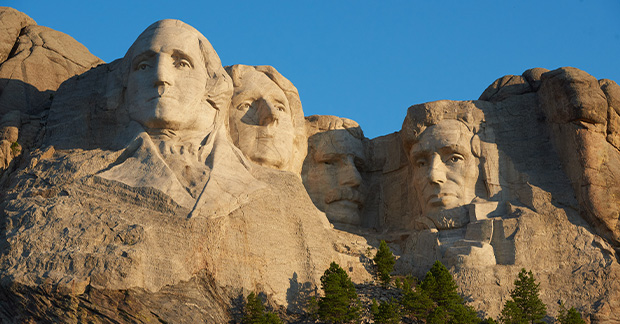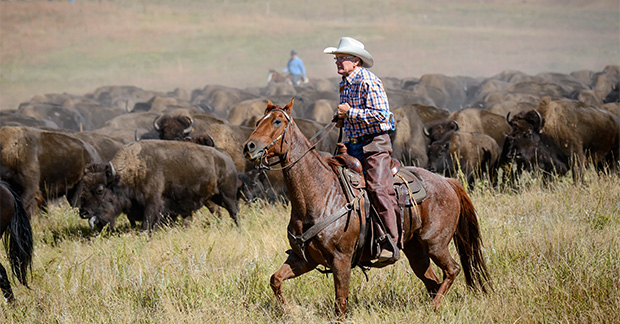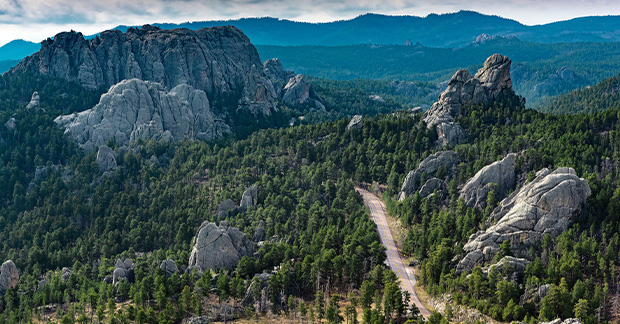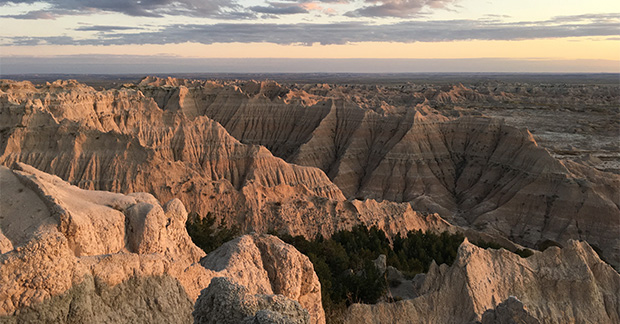You are viewing 1 of your 2 free articles
There’s more to South Dakota than Mount Rushmore
With its Crazy Horse Memorial and awe-inspiring landscapes, South Dakota isn’t just Mount Rushmore, says Rhonda Carrier
It’s on course to be the world’s largest statue, but South Dakota’s Crazy Horse Memorial, with its 26-metre-tall face of a Native American war leader, is invisible on our first late-September visit. Fog is swirling, and the first snows are forecast within days. We make do with the compelling visitor centre displays – including eagle-feather dance bustles and crooked-beak masks – and performances by local Native Americans.
Waking to blue skies the following day, however, we elect to return – and it’s worth the wait to see the memorial so clearly, surveying the rocky parkland. It was as far back as 1948 that Standing Bear, chief of the Lakota people of the Sioux tribe, asked Korczak Ziolkowski to create a memorial to a local Native American hero.

It was a response of a kind to the carving of nearby Mount Rushmore with its now world-famous depictions of US founding fathers George Washington, Thomas Jefferson, Theodore Roosevelt and Abraham Lincoln (hike the Mount’s Presidential Trail for the best in-your-face views).
The sculptor set to work knowing that the project would take longer than his own lifetime. For an idea of its scale, the four presidential faces on Mount Rushmore combined would fit easily into the face and head of Crazy Horse. Today, Ziolkowski’s children and grandchildren and their staff carry on his work.
The full design envisages Crazy Horse sitting atop a horse. Since finishing the Native American’s face, they’ve carved part of the hand and forearm, and are currently on a 11-year quest to finish the rest of the hand, arm and horse’s head. For the remainder of the horse, they have no idea of the timeframe but recognise that it will extend beyond their own lifespans too. This truly is a labour of love.

Cowboys, caves and canyons
Crazy Horse and Mount Rushmore are carved into mountains in the Black Hills, an area of great sacred significance to the various Sioux tribes, who call it the ‘big cathedral’.
Covering roughly 5,000 square miles of western South Dakota and extending into neighbouring Wyoming, the hills are also home to Wind Cave National Park, with its rare boxwork formations; Jewel Cave National Monument, the world’s third?longest cave; the Mammoth Site in Hot Springs, the world’s biggest mammoth research facility; Deadwood, the Gold Rush settlement that inspired the TV series and movie; and Custer State Park.

We visit the last of those at its most exciting time of year, late September, for the Annual Custer State Park Buffalo Roundup. Here, over two days, local cowboys and cowgirls gather and drive the park’s herd of around 1,300 buffalo into corrals, for testing, branding and sorting to keep the magnificent beasts strong and healthy. You can watch proceedings from viewing areas (bring binoculars).
New for 2022 – when the Roundup returns in its full form for the first time since 2020 – is the Custer State Park Bison Center, with fascinating displays on the preservation of the national mammal. The buffalo share all 71,000 acres of Custer State Park, one of the few truly wild places left in the US, with pronghorn, elks, mountain goats and burros, many of which you can encounter on a drive along the 18-mile Wildlife Loop Road.
Both sunset and sunrise visits are a must in this eerie landscape that proved such a physical and mental challenge to the pioneers
You can also explore parts of it on horseback, on scenic drives such as the Iron Mountain Road and Needles Highway, and via hiking trails, which range from easy to strenuous. Black Elk Peak, the highest point east of the Rockies, is a classic South Dakota hike, but my favourite was the fairly demanding one to two-hour Cathedral Spires Trail through some of the unusual pointed granite formations found along the Needles Highway.
The best hike of my stay, though, was in Badlands National Park, between towering buttes similar to the Needles, separated by steep canyons and gullies. Both sunset and sunrise visits are a must in this eerie landscape that proved such a physical and mental challenge to the pioneers.
There’s also a scenic drive, the Badlands Loop Road, plus hikes including the boardwalked Fossil Exhibit Trail with displays on local finds. When weather permits, the Badlands is also a heavenly place for stargazing.
My highlight, though, was the 90-minute Notch Trail, which rewards you for climbing a ladder up the face of one of the formations – and for potentially encountering a rattlesnake or two – with panoramic White River Valley views that truly show off the vastness of South Dakota.

Where to find local crafts
Sioux Pottery, Rapid City
A small factory where you can watch Jeanne High Elk and other Native Americans create Lakota designs from the sacred red clay of the Black Hills.
Star of the West Hat Company
The place to see where cowboy hats are made for everyone from everyday ranchers to rodeo champions, using wool, beaver, rabbit and horse hair.
Wall Drug Store, Wall
Here, 26 shops sell local crafts and foods – part of an iconic roadside stop with a reconstructed frontier town and dining room famed for its donuts.
Book it
America As You Like It offers six nights in South Dakota from £1,525 per person, based on two people sharing on a room-only basis, for departures in September 2023. The price includes return flights from Heathrow with American Airlines, SUV car hire, two nights in Rapid City at the Holiday Inn Rushmore Plaza, one night in Wall at Frontier Cabins and three nights in Custer State Park at Sylvan Lake Lodge.
americaasyoulikeit.com
For more information, visit greatamericanwest.co.uk and travelsouthdakota.com
PICTURES: Shutterstock/James Dalrymple; Visit The USA; South Dakota Tourism
Read more
x.travelweekly.co.uk/destinations/us-road-trips-5-of-the-best-rv-routes">US road trips: 5 of the best RV routes
x.travelweekly.co.uk/destinations/coasters-and-conservation-at-seaworld-parks">Rollercoasters and conservation at SeaWorld Parks
x.travelweekly.co.uk/destinations/why-indigenous-tourism-is-so-important-in-canada">Why Indigenous tourism is so important in Canada

